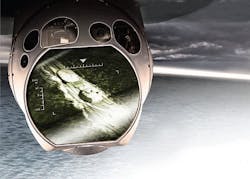L-3 to provide electro-optical laser rangefinders for Navy Multi-Spectral Targeting System (MTS)
CRANE, Ind. – U.S. Navy airborne surveillance experts needed eye-safe laser rangefinders for the electro-optical Navy Raytheon Multi-Spectral Targeting System (MTS). They found their solution from the L-3 Technologies Advanced Laser Systems Technology (ALST) segment in Orlando, Fla.
Officials of the Naval Surface Warfare Center Crane Division in Crane, Ind., have announced a $5.1 million five-year sole-source contract to L-3 ALST to supply and repair eye-safe laser range finders in support of the Raytheon MTS. The value of the upcoming contract has yet to be negotiated.
The Raytheon MST family consists of AN/AAS-44C, AN/AAS-52B, AN/DAS-1A, AN/DAS-4, AN/AAS-53, AN/ZSQ-2, MTS-C, and future derivatives. These systems provide intelligence, surveillance, and reconnaissance (ISR), detection, identification, and targeting capability in day and nighttime operations on manned and unmanned aircraft.
The L-3 laser rangefinders are key elements of the MTS, and have been integrated and qualified as part of this system. L-3 ALST is the only responsible source of laser rangefinders for the MTS, Navy officials say.
Related: Quantum Imaging to provide infrared electro-optics for multispectral targeting systems
Navy experts have purchased laser rangefinders for the MTS for more than 15 years, and have deployed more than 500 systems aboard manned and unmanned aircraft. Buying laser rangefinders and repair services from any other source would be too expensive and time-consuming, Navy officials say. Raytheon builds the MTS at the company's Space and Airborne Systems segment in McKinney, Texas.
Among the Navy aircraft hosting the MTS are the Navy Special Projects Aircraft (SPA) -- a secretive version of the P-3 maritime patrol four-engine turboprop outfitted for sensitive surveillance missions. This aircraft uses the MTS-C, which provides high-altitude target acquisition, tracking, range-finding, and laser designation, and can provide guidance for all tri-service and NATO laser-guided munitions.
The MTS-C includes a long-wave infrared detector, which is suitable for tracking cold bodies such as missiles and warheads after boost phase, as well as or plumes and exhaust of missiles and rockets during boost phase.
The Raytheon MTS family also is aboard the C-130 utility turboprop, SH-60 helicopters, Predator drones, and several other aircraft types. The MTS has an electro-optical and infrared full-motion video camera system that permits long-range surveillance and high-altitude acquisition, tracking and laser designation.
Related: Arete moves forward on multispectral UAV sensor payloads to find mines on invasion beaches
The Raytheon MTS family of turreted sensors can be fitted with multiple wavelength sensors, near-infrared and color TV cameras, illuminators, eyesafe rangefinders, image merging, spot trackers, and other avionics.
The multi-use system offers surveillance, target acquisition, tracking, rangefinding, and laser designation for the Hellfire missile and for all tri-service and NATO laser-guided munitions such as the Paveway Laser Guided Bomb.
This contract also will involve the L-3 Insight Technology segment in Londonderry, N.H. For more information contact L-3 ALST online at www2.l3t.com/alst, L-3 Insight at www.insighttechnology.com, or Naval Surface Warfare Center-Crane at www.navsea.navy.mil/Home/Warfare-Centers/NSWC-Crane.
Ready to make a purchase? Search the Military & Aerospace Electronics Buyer's Guide for companies, new products, press releases, and videos

